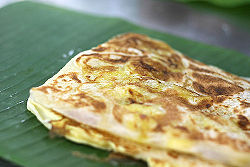Roti canai: Difference between revisions
mNo edit summary |
No edit summary |
||
| Line 12: | Line 12: | ||
Traditionally, it is served with ''[[dal]]'' or 'dhal' (lentil) curry, which in North India is prepared with [[chana dal]]. It can sometimes be taken with sugar or condensed milk. More recently, various improvements on plain roti have been devised to suit the more adventurous tastes of more affluent Malaysians and Singaporeans. Generally the newer forms of roti are denoted by using a prefix of ''roti'' attached to the additional ingredient used. One of the most common derivatives is ''roti telur'' or roti with fried eggs (''telur'' being the Malay word for egg). Other variations include ''roti tisu'' (tissue bread, a paper thin and flaky roti, also called ''roomali roti'', ''roomal'' means handkerchief in hindi), ''roti bawang'' (onion bread) and ''roti bom'' (bomb bread, a smaller but thicker roti) also popular is the ''roti planta'' which is roti stuffed with [[margarine]] and sugar. It is also interesting to note that most plain roti are round while those with fillings are square in shape due to the folding of the roti. |
Traditionally, it is served with ''[[dal]]'' or 'dhal' (lentil) curry, which in North India is prepared with [[chana dal]]. It can sometimes be taken with sugar or condensed milk. More recently, various improvements on plain roti have been devised to suit the more adventurous tastes of more affluent Malaysians and Singaporeans. Generally the newer forms of roti are denoted by using a prefix of ''roti'' attached to the additional ingredient used. One of the most common derivatives is ''roti telur'' or roti with fried eggs (''telur'' being the Malay word for egg). Other variations include ''roti tisu'' (tissue bread, a paper thin and flaky roti, also called ''roomali roti'', ''roomal'' means handkerchief in hindi), ''roti bawang'' (onion bread) and ''roti bom'' (bomb bread, a smaller but thicker roti) also popular is the ''roti planta'' which is roti stuffed with [[margarine]] and sugar. It is also interesting to note that most plain roti are round while those with fillings are square in shape due to the folding of the roti. |
||
Roti canai is very affordable, making it extremely popular. |
Roti canai is very affordable (standard price is RM0.60 a piece in Malaysia), making it extremely popular. |
||
==Preparation in pictures== |
==Preparation in pictures== |
||
Revision as of 06:04, 23 March 2007

Roti canai or Roti Chennai (known as Roti prata in Singapore) is a dish found in Malaysia, Singapore, and Kerala (India) . The pronunciation porotta is unique to Tamil and Malayalam; that pronunciation is derived from the North Indian word paratha. New versions of Roti include Roti Telur, Roti Bawang, Roti Bom, Roti Planta, Roti Pisang, Roti Tissue, and Roti Sardin.
Roti means bread in Hindi, Urdu, most other North Indian languages, and Malay. The term "canai" derives from "channa", a mixture of boiled chickpeas in a spicy gravy from Northern India which it was traditionally served with. The term "channa" is also used in Pakistan. In English, roti canai is sometimes referred to as "flying bread," a term that evokes the process of tossing and spinning by which it is made.
The dish is composed of dough containing copious amounts of fat, egg, flour and water. The form of fat used is usually ghee (clarified butter). The entire mixture is kneaded thoroughly, flattened, oiled and folded repeatedly. It is then allowed to proof and rise, and the process is repeated. The final round of preparation consists of flattening the dough ball, coating it with oil and then cooking on a flat iron skillet with a lot of oil. The ideal roti is flat, fluffy on the inside but crispy and flaky on the outside.
One of the characteristics of roti canai and its derivatives is that it can be eaten with the hands, without the need for utensils. This makes it a convenient dish to consume, while being filling. This characteristic makes it a dish of choice as breakfast or as supper (the fourth meal of the day, generally eaten after nightfall).
Traditionally, it is served with dal or 'dhal' (lentil) curry, which in North India is prepared with chana dal. It can sometimes be taken with sugar or condensed milk. More recently, various improvements on plain roti have been devised to suit the more adventurous tastes of more affluent Malaysians and Singaporeans. Generally the newer forms of roti are denoted by using a prefix of roti attached to the additional ingredient used. One of the most common derivatives is roti telur or roti with fried eggs (telur being the Malay word for egg). Other variations include roti tisu (tissue bread, a paper thin and flaky roti, also called roomali roti, roomal means handkerchief in hindi), roti bawang (onion bread) and roti bom (bomb bread, a smaller but thicker roti) also popular is the roti planta which is roti stuffed with margarine and sugar. It is also interesting to note that most plain roti are round while those with fillings are square in shape due to the folding of the roti.
Roti canai is very affordable (standard price is RM0.60 a piece in Malaysia), making it extremely popular.
Preparation in pictures
-
The mixture is kneaded, flattened, and then oiled, before being folded repeatedly.
-
Roti canai is cooked on a flat iron skillet with a lot of oil.
-
Another picture of Roti Canai making
See also
- Mamak stall
- Paratha
- Kerala Porotta
- Roti prata, the Singaporean variant.



